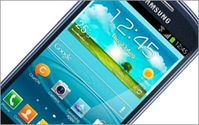 Smartphones aren’t quite at the commodity stage, but there’s evidence that price is becoming a determining factor when people are choosing a new phone.
Smartphones aren’t quite at the commodity stage, but there’s evidence that price is becoming a determining factor when people are choosing a new phone.
In its most recent Smartphone Satisfaction Study, J.D. Power Associates found that just over a fifth of smartphone owners cited “price” as the main reason they chose their
particular device, up from 13% in 2011. Meanwhile, “features” have been losing importance over the same period of time. For the 2014 study, 35% of users cited features as their primary
selection factor, down from 57% in 2011.
“[Smartphone selection] is typically led with something that’s different that no one else has,” Kirk Parsons, senior
director of telecommunications services at J.D. Power, tells Marketing Daily. “It’s becoming less and less so because the leap in technology is less advanced. … In the last
year or so there hasn’t been much out there that has blown people away.”
advertisement
advertisement
At the same time, smartphone prices have gone up. According to the study, the average smartphone
cost was $202, up from $174 in 2011. Fewer owners are also receiving discounts on their phone than in 2011. Consumers who selected a smartphone based on price had lower levels of satisfaction
(808 on a 1,000-point scale) and lower repurchase rates (18%) than consumers who selected a phone for other reasons.
The changes reflect a maturation of the smartphone market,
Parsons says, where consumers now have an idea of what they use their smartphones for most, and can take a pass on features that aren’t useful. “The bells and whistles are all well and
good,” Parsons says. “But it’s the blocking and tackling about figuring out what people use their phones for, and doing those things well, that sell phones.”
That’s not to say that consumers aren’t looking for new ideas from smartphones. According to the survey of more than 13,000 smartphone users, the features they would like to see
on their next device include seamless voice control (cited by 36%), sensors that can adjust phone settings to the surrounding temperature, lighting and noise (35%) and biometric security sensors
(28%).
“To get ahead of the competition and satisfy customers, manufacturers must meet the expectations of customers, ensuring the features they want next are intuitive
and rewarding,” Parsons says. “Providing an easy-to-use, yet powerful operating system with the ability to customize applications to suit individual needs is essential to providing a
high-quality and positive wireless experience.”
• Reasons for purchase have an impact on customer satisfaction and future loyalty. Selecting a smartphone device based on
price generates significantly lower levels of satisfaction (808 on a 1,000-point scale) and repurchase rates (18%) than selections based on product-specific reasons such as operating system (860 and
35%, respectively).
• In 2014, the average purchase price for smartphone devices has increased and owners are less likely to receive a discount. On average, smartphone owners
indicate that their device cost $202 in the 2014 Vol. 1 study, an increase from $174 in the 2011 Vol. 2 study. More than half (52%) of owners have received a discount on their smartphone in 2014 Vol.
1, compared with 60 percent in the 2011 Vol. 2 study.
• Overall satisfaction with smartphone devices is highest among AT&T customers (844), followed by Sprint (839);
T-Mobile (835); and Verizon Wireless (829) customers. Overall satisfaction among smartphone owners is 837.
The 2014 U.S. Wireless Smartphone Satisfaction Study-Volume 1 is based on
experiences evaluated by 13,237 smartphone customers who have owned their current smartphone device less than one year and who are customers of the four Tier 1 carriers. The study was fielded between
September 2013 and February 2014. The study measures customer satisfaction
in four factors: performance (31%); physical design (23%); features (23%); and ease of operation (23%).